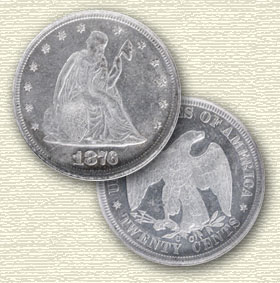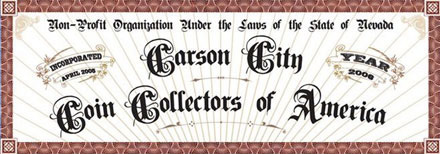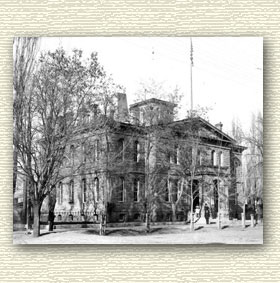- Posts: 614
- Thank you received: 0
1876-CC Seated Quarter CC Coin of the Week 9-19- 2010
Less
More
15 years 1 month ago - 14 years 3 months ago #1505
by Garryn
1876-CC Seated Quarter CC Coin of the Week 9-19- 2010 was created by Garryn
The Carson City Mint was in full swing in 1876. That year the Mint produced 4.9 million quarters, more than at any other time in their 9 year run. In fact, Carson City's production was 28% of the Philadelphia Mint's production of 17.5 million quarters. In 1877 the mint would produce 4.2 million more and would round out the production in 1878 with 996,000.
Rusty Goe in The Mint on Carson Street, mentions the fact that the sudden upsurge in production in 1874 and following was remarkable since the staff only increased by 14%.
But due to the high mintage figures, the survival rates are also remarkable. It is estimated that between 5-10,000 exist in all grades and 500-600 are in mint state. 1,000-1,500 may exist in XF to AU. So there is a specimen for anyone who cares to have one.
As an aside, the Seated Liberty design appeared in 1836 and was used on virtually all silver coinage in the United States until Charles Barber did a major redisign in 1892. The Seated Liberty design and the reverse eagle design of the Gobrecht Dollars were sketched by noted painters Thomas Sully and Titian Peale. Christian Gobrecht, acting Chief Engraver of the US Mint engraved the dies that created the first circulated Seated Liberty Coinage in 1837. Seated Liberty quarters first appeared in 1838.
As I mentioned in my discussion of the 1876 dime on October 19, the year 1876 was the country’s Centennial and the Centennial Exhibition opened on May 10. Rutherford Hayes was elected President, succeeding General U.S. Grant and Colorado was admitted as the 38th state.
One of the most storied events in US history occurred in 1876 at the Little Big Horn River in Montana. There General George Custer's 7th Cavalry attacked Cheyenne and Lakota tribes at their camp on the Little Big Horn River on June 25, 1876. Custer did not realize how large the camp was. More than 2,000 Native Americans were there with a Lakota Sioux tribal chief and holy man, Sitting Bull. The 7th Cavalry was outnumbered 3 to 1. Approximately 1800 to 600. On the Native American side, warriors were made up of Lakota Sioux, Cheyenne, Dakota and Arapahoe. The 7th Cavalry lost 16 officers and 242 troops, including Custer. 24 Medals of Honor were awarded in 1878.
Chief Gall,Lakota Sioux commander at Little Big Horn
Sitting Bull. Lakota Sioux tribal chief. Sitting Bull reportedly did not participate in the battle, but took up a defensive position at the camp.
Memorial to Cheyenne warrior on the battlefield.
Three of Custer's Crow scouts who survived the Battle; L to R: White Man Runs Him, Goes Ahead, and Hairy Mocassin, pictured in 1907.
Brevet Major General George Armstrong Custer in 1865 at age 26
When General Custer died, he was 36 years old. Originally buried on the battlefield, he is now interred at West Point.
Rusty Goe in The Mint on Carson Street, mentions the fact that the sudden upsurge in production in 1874 and following was remarkable since the staff only increased by 14%.
But due to the high mintage figures, the survival rates are also remarkable. It is estimated that between 5-10,000 exist in all grades and 500-600 are in mint state. 1,000-1,500 may exist in XF to AU. So there is a specimen for anyone who cares to have one.
As an aside, the Seated Liberty design appeared in 1836 and was used on virtually all silver coinage in the United States until Charles Barber did a major redisign in 1892. The Seated Liberty design and the reverse eagle design of the Gobrecht Dollars were sketched by noted painters Thomas Sully and Titian Peale. Christian Gobrecht, acting Chief Engraver of the US Mint engraved the dies that created the first circulated Seated Liberty Coinage in 1837. Seated Liberty quarters first appeared in 1838.
As I mentioned in my discussion of the 1876 dime on October 19, the year 1876 was the country’s Centennial and the Centennial Exhibition opened on May 10. Rutherford Hayes was elected President, succeeding General U.S. Grant and Colorado was admitted as the 38th state.
One of the most storied events in US history occurred in 1876 at the Little Big Horn River in Montana. There General George Custer's 7th Cavalry attacked Cheyenne and Lakota tribes at their camp on the Little Big Horn River on June 25, 1876. Custer did not realize how large the camp was. More than 2,000 Native Americans were there with a Lakota Sioux tribal chief and holy man, Sitting Bull. The 7th Cavalry was outnumbered 3 to 1. Approximately 1800 to 600. On the Native American side, warriors were made up of Lakota Sioux, Cheyenne, Dakota and Arapahoe. The 7th Cavalry lost 16 officers and 242 troops, including Custer. 24 Medals of Honor were awarded in 1878.
Chief Gall,Lakota Sioux commander at Little Big Horn
Sitting Bull. Lakota Sioux tribal chief. Sitting Bull reportedly did not participate in the battle, but took up a defensive position at the camp.
Memorial to Cheyenne warrior on the battlefield.
Three of Custer's Crow scouts who survived the Battle; L to R: White Man Runs Him, Goes Ahead, and Hairy Mocassin, pictured in 1907.
Brevet Major General George Armstrong Custer in 1865 at age 26
When General Custer died, he was 36 years old. Originally buried on the battlefield, he is now interred at West Point.
Last edit: 14 years 3 months ago by Garryn.
Please Log in to join the conversation.
- coindrummer
-

- Offline
- Platinum Member
-

- Michael D. Parrott
Less
More
- Posts: 775
- Thank you received: 0
15 years 1 month ago #1507
by coindrummer
C4OA Lifer!
Replied by coindrummer on topic Re:1876-CC Seated Quarter CC Coin of the Week 9-19- 2010
Hi Garryn
I have been a bit delayed but finally got to see view your wonderful article on your 1876-CC quarter.
I understand that two major varieties of this issue exist (other than the wide, tall, small "CC"). There is a normal denticle variety and a fine (smaller) denticle variety. Do you happen to know which of the two your example is?
You have a very nice coin shown here.
Michael the drummer
I have been a bit delayed but finally got to see view your wonderful article on your 1876-CC quarter.
I understand that two major varieties of this issue exist (other than the wide, tall, small "CC"). There is a normal denticle variety and a fine (smaller) denticle variety. Do you happen to know which of the two your example is?
You have a very nice coin shown here.
Michael the drummer
C4OA Lifer!
Please Log in to join the conversation.
Less
More
- Posts: 614
- Thank you received: 0
15 years 1 month ago - 15 years 1 month ago #1509
by Garryn
Replied by Garryn on topic Re:1876-CC Seated Quarter CC Coin of the Week 9-19- 2010
I do not know which denticle variety that is, but it is a good opportunity to research it
Last edit: 15 years 1 month ago by Garryn.
Please Log in to join the conversation.
- coindrummer
-

- Offline
- Platinum Member
-

- Michael D. Parrott
Less
More
- Posts: 775
- Thank you received: 0
15 years 1 month ago #1511
by coindrummer
C4OA Lifer!
Replied by coindrummer on topic Re:1876-CC Seated Quarter CC Coin of the Week 9-19- 2010
Hi again Garryn
The two 1876-CC seated quarters: 1. normal reed 2. fine reed
I don't hear much about these two varieties but I know they exist. It'd be nice to have an example of each.
the drummer
The two 1876-CC seated quarters: 1. normal reed 2. fine reed
I don't hear much about these two varieties but I know they exist. It'd be nice to have an example of each.
the drummer
C4OA Lifer!
Please Log in to join the conversation.
Less
More
- Posts: 614
- Thank you received: 0
Time to create page: 0.133 seconds







